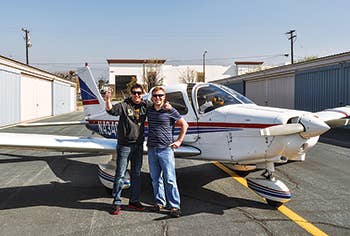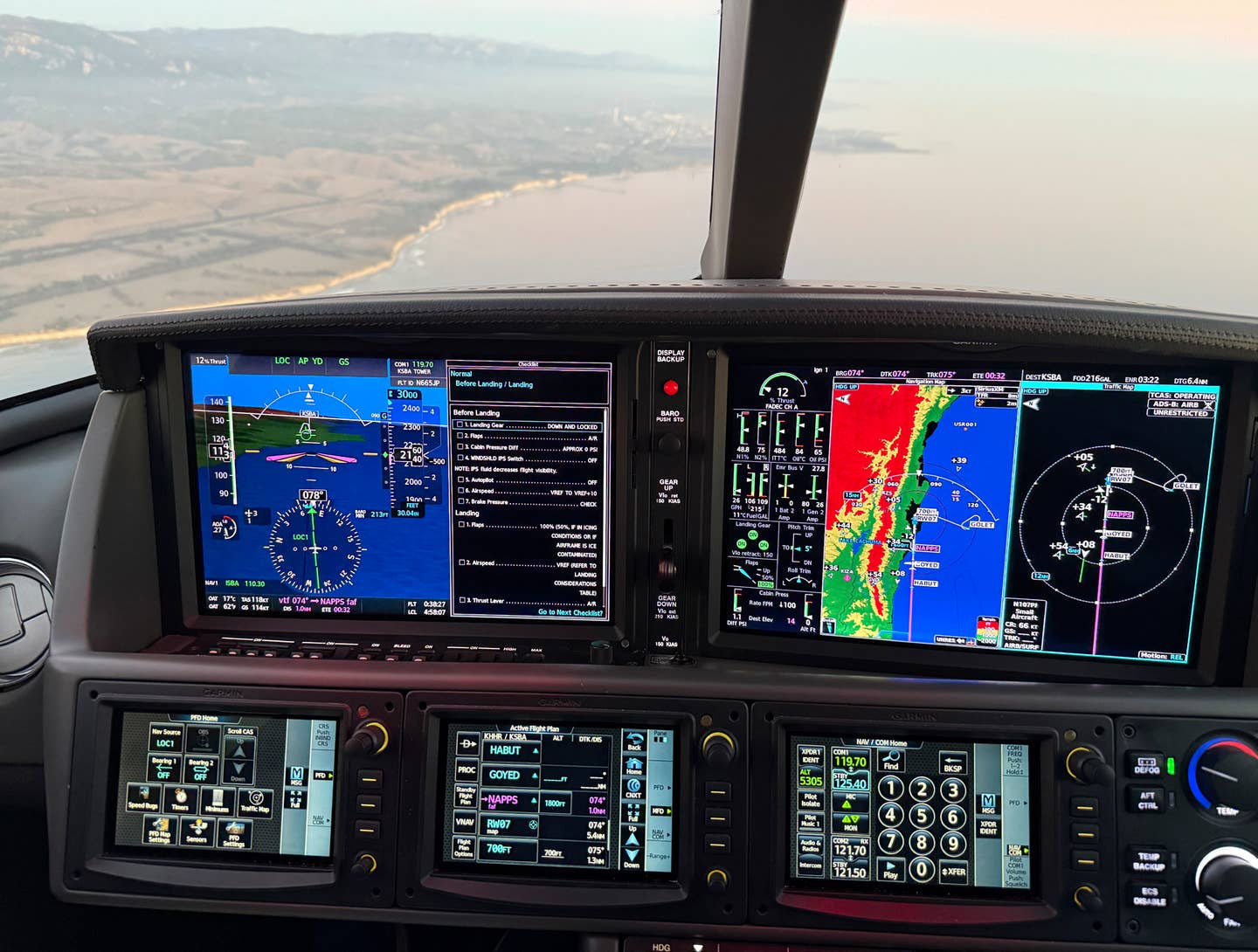
It was late, the end of a long and trying day, and we hadn't even left the state of Texas. I caught glimpses of muted scrubland far below as we flitted in and out of dusky cumulus. I shifted in the right seat and glanced over at Johnny in the dim red cockpit light. The Foggles were off for his first foray into actual IMC; his eyes moved rapidly across the instruments, over the radios and down to his iPad and the en route chart on which he was plotting our stately progress. He thumbed the trim wheel and made a minute adjustment, holding the yoke with his fingertips and nodding in satisfaction when the ship was in trim again. The No. 2 CDI centered, and Johnny wrote the time next to a fix on his chart and twisted the OBS to the next cross radial. He reached up to dim the red light as the last twilight faded, and then turned off the pulsing wingtip strobes. I suddenly had the sense of watching myself fly, like a parent recognizing themselves in their child's mannerisms. I was happy to see that my lessons had stuck, a decade after I had taught them.
Ten years earlier, Johnny had walked into Air Desert Pacific of La Verne, California, and demanded its best, most experienced flight instructor. He got me instead. I was recently returned from the frozen tundra of Grand Forks, where I had finished my degree at the University of North Dakota and flight instructed during my senior year. But a lot had changed in the eight months since I'd left Southern California, beginning with the events of Sept. 11. Both major and regional airlines were furloughing thousands. Flight schools, already hit hard by the weeks-long grounding after the attacks, were seeing a marked downturn in training that would never entirely recover and would conspire with spiraling fuel and insurance costs to put many out of business. But nobody knew that yet, and most of my friends and I were adjusting our plans for what we assumed was simply another cycle in a notably cyclical industry. In my case that meant flight instructing longer than planned. I didn't mind; the initial struggles had faded, I had seen a few things that could kill me, I'd learned better ways to teach, and I had discovered that I actually enjoyed instructing. But I'd be damned if I'd suffer through another North Dakota winter — it was back to sunny SoCal for me, crowded airspace and all.
"Rock Star Johnny" was one of my first students after my return to ADP. He was actually a literal rock star, of sorts: Johnny was the lead vocalist of Hardline, an '80s hair band born too late in the early '90s. They toured with Journey and Van Halen, but the rise of grunge killed any chance of long-term success; even today Johnny winces at the mention of Eddie Vedder. He's still active in music, singing for Axel Rudi Pell with a loyal following in the European metal scene. But that's mostly a hobby; Johnny made his fortune starting a product distribution company that rode the leading wave of the e-commerce revolution.
I learned these things well into his primary training. Before that, it was clear that Johnny was a rock star of a different sort: the natural student, the sort who instinctively understands flying and requires minimal instruction. Flight instructors may profess to not playing favorites, but this sort of student is always a favorite. They make our jobs easy, and they make us look good. Mind you, even natural students need to have their abilities channeled. They are very often Type A personalities and can become overconfident in their skills before their experience level supports it. They can also be impatient with the more mundane aspects of training. In Johnny's case, rote study assignments were often neglected. My challenge became finding easy ways for him to remember important information, and relating exactly why he needed to know it.
Most students, of course, are not rock stars. Flying is not a natural activity to most of us and becomes second nature only through long and tedious repetition with frustrating plateaus and regressions. Some people, I've come to realize, are not cut out for flying at all. Take "Rose," for example. When I inherited her, Rose had already flown about 50 hours toward her instrument training and wasn't even close to done. Her logbook showed that it had taken over 150 hours to get her Private Pilot certificate. This woman didn't lack intelligence: She was a well-educated senior financial analyst for a major investment bank.
Her knowledge level was excellent; unlike Johnny, any overnight study assignments were sure to be complete the next day. But her brain was simply not wired for spatial reasoning, and she had a strong panic response when she became unsure of her position or overwhelmed with tasks. I flew with Rose for another 40 hours and became rather impressed with her resilience. Most people would have thrown in the towel long before. Perhaps that influenced my decision to sign her off for the checkride. I really thought she was finally ready. In fact, she failed in less than five minutes by botching a departure procedure, panicking and banking into an unusual attitude that required examiner intervention. She was my first student to fail a ride. Out of vacation time but undeterred, Rose flew home to New York determined to find another instructor and finish her instrument rating.
Rose was an exception. Most people are capable of becoming fine pilots given the right attitude, enough time and opportunity, and competent instruction. Some just have greater obstacles to overcome than others.
Josh was a Taiwanese national who barely spoke English when I met him, never mind that he already had his PPL. Shortly thereafter he busted San Diego Class B while alone on a time-building cross-country, managing to overfly both MCAS Miramar and Lindbergh Field! How he escaped getting shot down so soon after 9/11, and how I dodged a 709 ride, I don't know. But after that incident Josh attended ESL classes every night and eventually improved to the point of being able to field SoCal Approach's rapid-fire clearances without too much trouble.
When I first flew with commercial student Bert, his flying was sloppy, checklist discipline nonexistent, and anti-authority demeanor palpable. I had to sit him down and have a stern talk about what it means to be a commercial pilot — tough to do with a straight face when you're 21 years old with 800 hours. But Bert took my advice to heart, changed his attitude and became a fine commercial pilot who eventually flew for the regional airlines. Josh, meanwhile, is flying B747s for a Taiwanese airline. Another former student, Artur Kielak, is a B737 captain for Ryan Air and competes with the Polish national aerobatic team. At last count, I have former students flying professionally on five continents, plus many who fly for recreation in the States. I keep in contact with several of them and also with many former ADP instructors now scattered across the aviation industry. My close friend and frequent co-conspirator in various motorcycling and travel adventures, Brad Phillips, was a former MEI student and co-worker at ADP. He was subsequently hired by Horizon Air and helped get me my first airline job there.
Flight instructing isn't always an easy way to make a living, even for experienced CFIs, but it was an invaluable experience I wouldn't trade for anything. I still keep my ticket current because you never know what aviation will dish out next, and because I enjoy flying with former students when they need a CFI. That's how I ended up flying with Johnny 10 years after teaching him to fly in Southern California. Since then Johnny had semiretired and moved to Connecticut, but waited to bring his pristine 1984 Piper Warrior across the country until a hangar opened up at his local airport. Rock star or not, Johnny thought he could use some help on such a long flight, and then he decided he'd like to get some instrument instruction along the way. I jumped at the chance of a cross-country adventure with my old student.
The crackle of the radio broke the silence as Fort Worth Center issued a descent clearance and Johnny eased back on the throttle. Within minutes we broke out of the clouds and the lights of Dallas filled the windscreen. It was a long day that began with a six-hour delay in El Paso due to a stuck trim servo. But we soon landed, put the Warrior to bed and regrouped over well-deserved pizza and beer. The next few days would involve dodging thunderstorms across the South and getting rerouted all over the Northeast. Johnny, as usual, would handle it all like a rock star. As for me, the right seat of that Warrior felt pretty darn good. It sparked warm memories of a time when I was a broke kid hustling for flight hours from sunup to sundown, doing my damnedest to fake it as ADP's best, most experienced flight instructor.
Get online content like this delivered straight to your inbox by signing up for our free enewsletter.

Sign-up for newsletters & special offers!
Get the latest FLYING stories & special offers delivered directly to your inbox






